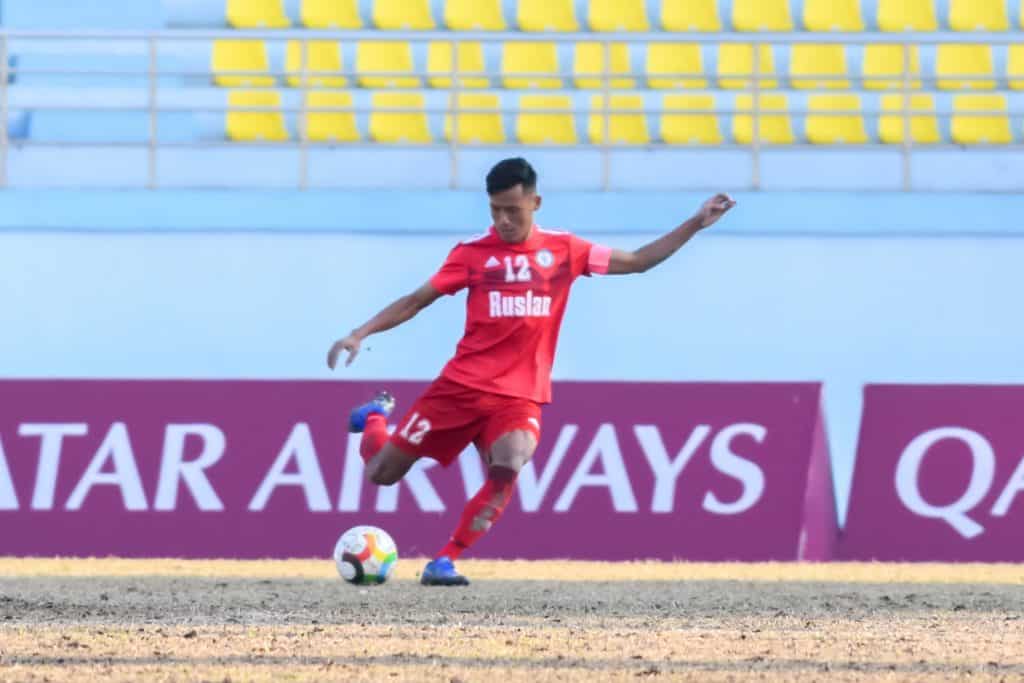- ‘Football is worth giving it all’ — the origin story of Bikram Lama
- Bikram Lama: The Rise and The Redemption
- Bikram Lama and tales of resilience
October 2009, Lalitpur.
The streets of Chyasal are relatively quiet amidst the festive season going on. Despite going unnoticed as a town for most of the time, Chyasal carries an ancient story of a hard-fought war between the dynasties that wanted to rule over the valley of Kathmandu at around 250 AD. The tales of a final push for glory – between then-ruling Kirants and the Lichhavis – echoes inside the town to date. 800 Kirants guarding the post died, and the city derives its name from the number 800, as it translates to chyasa in the local Newari tongue.
Modern-day Chyasal accustoms well-preserved monuments that reflect Patan’s ancient art and sculpture. Amidst the artefacts lies a dense settlement of both indigenous and migrants from all over the country. The town sandwiched between Patan Durbar Square and Kathmandu also houses a small and maintained football arena – a rare sight within Kathmandu valley.
Amidst the quietness of the town, a 20-year-old Bikram Lama is pushing hard to make his dreams of returning to the pitch, after realizing his dreams of embracing glory with the Nepali National Team, come true. This resonates with the town’s tales of the final push.
“I started with light drills and a couple of sprints. I grew up at Chyasal, and the presence of a football pitch nearby was a huge advantage for the whole recovery process. I had to keep reminding myself that this will, someday, yield results if I keep putting my work in.” Lama continued to get back to normal and was looking for a breakthrough.
However, the conundrum of not making it to the utmost level and making things worse for himself always surrounded his head. The breakthrough moment finally arrived, as Lama was called up by a local team to play small-scale tournaments outside of Kathmandu. With relatively less competition and a means of re-cementing his career, those tournaments felt like a perfect fit for the young midfielder.
Despite the dilemma, the decision of starting small proved worthy. A successful outing at Pokhara saw Jawalakhel Youth Club take notice of their former player yet again, and no time was wasted. “My friends were all enjoying the top-flight, and I knew I had to make that leap to justify all the work that I had put on to get back to where I thought I belonged.” Bikram Lama recalls the feeling when Jaggu Khadka and Rajkumar Ghising made his move to JYC possible.
The second spell, in Lama’s young career, started. The reunion with Jawalakhel meant he was eligible to contest in the 2010 A Division League, up top with the finest players of the country. This also could be a probing season for Bikram Lama’s career, as he sought to see if he still had what it takes to make it. Lama debuted under Suman Yonjan against Nepal Army in the league, testing his resilience yet again. JYC lost the fixture, and clouds of self-doubt started surrounding Lama yet again. However, the determination to make things happen kept the drive on.
As tough as the start was, the end was even better. Jawalakhel Youth Club embarked on one of their finest league finishes ever, defeating even the strongest sides that came along. Bikram Lama was awarded JYC’s best player of the season, for his tireless service in the middle of the pitch. The determination paid off yet again, and Lama’s resurgence at the top level was noticeable.
Lama’s sudden burst garnered attention, and it was not long after that Three Star once again came knocking for a player that they accommodated as a teenager. Lalit Krishna Shrestha, Three Star Club’s President, convinced Lama to return to the Stars, and the deal was done. Bikram Lama was a Three Star player yet again.
“It was one of those moments in life when you feel very happy and see yourself going in the right direction. I felt like a professional yet again and made the decision to sign for one of the biggest clubs in Nepal,” Lama adds there was a moment of sadness, as he had memories with JYC as well. “I’ll always be thankful to the whole JYC family, for accepting me when I was down and making me what I am today. The decision was hard to take, yet I’ll always love JYC with all my heart.”

However, things were not always simple and straightforward in Bikram “Tackle” Lama’s career.
After joining the Stars yet again and dedicating himself to make the best out of every opportunity, expectations started to backfire. “The first six months at Three Star were really hard for me. I was inconsistent, and the badge felt heavier than ever, especially for a player returning to the side after a long struggle with a major injury,” Bikram Lama sounds more serious than ever in his interview. “The expectations got better of me, and all that was left was to work hard like I always did. It has always been like that for me.”
Bikram Lama’s return season was an unusual one for Three Star Club too, as the departure of senior players to arch-rivals, Manang Marsyangdi Club left them with young players and a few seniors to take the lead. Against the odds, Three Star managed to pull off a decent season and defeated Manang in each outing that season. Overtime, Bikram Lama also got in the vibe and the season ended with huge potential for the Stars.
A promising end of the season meant Three Star traveled to east Nepal to contest in coveted Cup tournaments. Managing to get himself established as a regular starter, this was Bikram Lama’s chance to take. Things did not take a twist this time and everything worked wonders. Lama finished as the highest scorer at Dhankuta Gold Cup after an impressive display in Budhasubba Gold Cup. Bikram Lama pulled off a rare feat – we do not always see defensive midfielders finishing a tournament as the top scorer.
“Things started to make sense. Being true to myself, accepting my weaknesses to succeed, and staying positive to head in front worked for me. They sound simple.” Lama felt his rejuvenation. “I really felt I belonged at the level of football that was being played around me. The following season worked out well, and everyone started to compliment me.”
The national team still felt too far for Lama, despite his colleagues frequently nudging him about a possible call-up. Ever since his first season, Lama barely missed Three Star’s regular fixtures and had cemented himself as one of Nepal’s finest defensive midfielders. Dasharath Stadium echoed chants of “Tackle Lama” due to his ability to time tackles well. All that was missing was a national team jersey.
“I wasn’t unhappy about not being called up to the national team. I always analyzed my gameplay day-in and day-out, and found bits that I could improve to be a better player,” Lama sounds well-aware as he continues. “National team call-up, however, was a dream I wanted to embrace someday.”

The long wait finally ended for Lama. Nepal NT’s new manager Jack Stefanowski, who had just been appointed to take charge, included Three Star’s talismanic defensive midfielder in his first ever venture in South Asia. A domestic league triumph with Three Star, a brilliant individual season, and the first national team call up – everything seemed too good to be true for a player that nearly left football at crossroads some four years ago.
“The moment I saw my name on the national team sheet, I knew my decision to not give up on the dream was correct. And hence, it happened… Stefanowski handed me a debut in the second half against Pakistan. To add on top of that, Stefanowski later praised me for doing exactly what I was supposed to do.” Lama sounded happier than ever when recalling his first moments with Nepali NT.
The series of National Team call-ups continued to arrive, and Lama’s stint with continued to grow. Lama believes his adherence to what the coach wanted of him made the call-ups frequent. “I always studied what Jack [Stefanowski] wanted of me, how he wanted his defensive midfielder to be, and what he ultimately wanted to achieve with me. Not only did it provide me some playing time, but helped me discover a new dimension of how an individual can do good for the team’s tactics.”
Since Nepal’s domestic league was put on halt due to various internal conflicts, players were forced to play local cup games, and the national team was the only other way to make things tick. Amidst everything, Nepal National Team prepared to host the 2013 SAFF Championship, the biggest South Asian footballing fiesta. Bikram Lama, by then, had been a regular at the national team’s camp with scarce minutes on the process.
Then came the day – the inaugural match of the SAFF Championship between Nepal and Bangladesh. Nepal won 2-0 against a regular opponent, and Bikram Lama made a brief five-minute cameo on the occasion. However, Lama’s highlight of the tournament came against the archrivals India. “That game as much as I can remember,” continues Lama, “was one of the best games that I’ve ever been a part of. We defeated India after 21 long years, and doing in front of our own beloved fans was extraordinary. They treated us as if we’d just won a major tournament after the match.”
What made things better for Lama was his involvement in Nepal’s first goal against India. After a balanced first half, then-coach Jack Stefanowski introduced Lama to do his regular defensive midfielder duties. The 70th minute saw Sandeep Rai’s freekick getting deployed inside the box, and amongst the crowd, it was Bikram Lama’s header that rebounded off the post. The rebound found Jumanu Rai, who took no time to net Nepal’s first. One-nil Nepal and Bikram Lama finally felt he was ready to compete for a regular place at the Nepali National Team.
The tournament did not end well for Nepal, as the hosts succumbed against eventual champions Afghanistan in the semis. What seemed like a resurgence ended. While Nepali National Team prepared itself for yet another way out, people barely noticed the emergence of Bikram Lama – a player who made things tick for Nepal for years to come.
